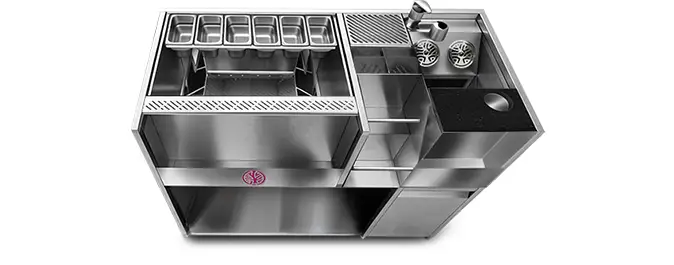What is the 52″ Standalone Stainless Steel Cocktail Bar Station?
A 52″ standalone stainless steel cocktail bar station is a purpose-built workstation designed for professional drink preparation, featuring integrated components such as ice wells, speed rails, and sinks to optimize service efficiency and hygiene.
Its corrosion-resistant surface and modular-friendly design ensure fast cleaning cycles, reduced cross-contamination risks, and consistent presentation quality. For example, bartenders in fast-paced venues complete up to 200 orders per shift with fewer service disruptions thanks to organized ingredient access and built-in drainage.
Beyond basic durability and sanitation, this 52″ station anchors a venue’s operational flow by centralizing tools and ingredients within ergonomic reach. This centralized design reduces unnecessary movement behind the bar and accelerates order turnaround, setting the stage for exploring its specific configurations and advantages.
What are the Key Features of the 52″ Standalone Cocktail Bar Station?
This modern 52″ cocktail bar station combines multiple functional elements in a single unit to support mixology tasks without clutter. Key features include integrated ice bins, speed rails for frequently used bottles, underbar sinks for glassware rinsing, drainboards for quick drying, and optional garnish wells. Each element is positioned to minimize motion and maximize workflow continuity.
These combined features create a cohesive workstation that underpins efficient drink preparation. Understanding these fundamentals leads directly into why stainless steel is the material of choice for these stations.
Why is Stainless Steel the Unmatched Material for Your Bar Station?
Stainless steel offers unmatched corrosion resistance, non-porous hygiene, and long-term durability under constant moisture and heavy use. Its smooth, inert surface prevents bacterial harboring and withstands acidic cocktail ingredients without pitting or discoloration.
In high-volume environments, stainless steel panels resist dents and maintain a professional appearance over years of service.
Sanitary standards often dictate specific grades of stainless steel for food and beverage equipment to ensure safety and longevity.
|
Property
|
Characteristic
|
Advantage
|
|
Corrosion Resistance
|
304-grade stainless steel
|
Prevents rust and pitting in wet areas
|
|
Non-Porous Surface
|
Smooth, sealed finish
|
Inhibits bacterial growth and staining
|
|
Mechanical Strength
|
High tensile strength
|
Withstands daily impact and heavy loads
|
|
Thermal Conductivity
|
Rapid heat dispersion
|
Maintains stable temperature for ice wells
|
These material properties translate directly into reduced maintenance costs, consistent sanitation compliance, and extended equipment lifespan. With durability assured, next we examine how this station’s design accelerates drink preparation workflows.
How Does the 52″ Standalone Bar Station Optimize Drink Preparation?
An integrated 52″ cocktail station enhances efficiency by placing tools and ingredients within arm’s reach, eliminating repeated trips to separate storage or wash areas. Speed rails position the top-selling liquors in sequence, while ice bins deliver chilled supplies without interrupting mix cycles. Underbar sinks and drainboards streamline glass rinsing and drying overhead.
Key workflow improvements include:
-
Minimized bartender steps between prep and service areas
-
Seamless transfer of ice from bin to shaker without cross-contamination
-
Instant access to garnishes in adjacent wells
-
Organized bottle layout that aligns with menu rotation
By reducing extraneous motions and consolidating stations, venues increase order throughput by up to 25 percent during peak hours. This efficiency foundation prepares us to explore the various station types that suit different operational footprints.
Understanding the 52″ Standalone Commercial Cocktail Bar Station
Commercial cocktail bar stations vary in configuration to suit venue size, mobility needs, and service models. The 52″ standalone unit is typically designed for permanent installations, offering a robust, self-contained solution. This type addresses distinct operational requirements without sacrificing core stainless steel benefits.
What are the Detailed Specifications of the 52″ Standalone Commercial Cocktail Bar Station?
This 52″ standalone cocktail bar station is engineered for optimal performance and efficiency. Below are its core general specifications:
|
Category / Feature
|
Specification
|
|
Dimensions (L × W × H)
|
1325×600×985 mm (52″ × 23.62″ × 38.78″)
|
|
Weight
|
114 kg / 251 lb
|
|
Footprint (L × W)
|
0.80 m² / 8.6 ft²
|
|
Ice Chest Capacity
|
135 L / 4565 fl oz / 35.66 gal
|
|
Real-World Servings
|
~ 200 cocktails
|
|
Venue Coverage (per single station)
|
~ 80–120 guests
|
|
Operational Crew Capacity
|
1 – 2 bartenders
|
|
Installation Type
|
Standalone
|
|
Insulation Value
|
R-3 (3/4″ elastomeric)
|
|
Ideal For
|
Flexible, Compact built-in setups, Mobile / space-limited bars, Multi-station setup
|
Selecting the right station type depends on factors such as available space, service style, and customization preferences.
Understanding these variations clarifies how venues can tailor setup to operational flow.
What Makes the 52″ Standalone Station a Robust Underbar Solution?
The 52″ standalone cocktail station is a fixed installation designed to fit beneath a bar countertop, offering a compact footprint with full workstation capabilities. These stations typically include built-in sinks, ice bins, speed rails, and drainboards arranged to optimize a bartending zone.
-
Efficient use of vertical space under a service counter
-
Permanent plumbing and electrical integration for consistent performance
-
Robust construction that anchors heavy equipment securely
-
Seamless integration with bar counters and overhead shelving
By embedding all essential components into a unified underbar framework, venues ensure a stable, efficient mixology zone that supports high-volume service demands without shifting equipment.
What are the Essential Components and Features of the 52″ Standalone Stainless Steel Cocktail Bar Station?
Every 52″ standalone stainless steel cocktail bar station is composed of critical elements engineered to support mixology workflows while ensuring hygiene and durability. Core components include ice bins, cold plates, speed rails, bar sinks, drainboards, blender slots, and garnish wells. Each feature contributes to a cohesive preparation zone.
By examining these components in detail, bartenders and venue managers can make informed decisions about station layouts and accessory combinations.
How Do Ice Bins and Cold Plates improve Bar Station Functionality?
Ice bins paired with cold plates deliver chilled supplies and maintain ingredient temperatures to prevent beverage dilution. Ice bins provide insulated storage, with a generous capacity of 135 L (4565 fl oz / 35.66 gal), while cold plates absorb heat from melting ice, preserving ideal service conditions.
|
Component
|
Function
|
Benefit
|
|
Ice Bin
|
Stores and chills bulk ice (135 L / 4565 fl oz / 35.66 gal capacity)
|
Minimizes time spent refilling supplies
|
|
Cold Plate
|
Maintains sub-zero ice surface
|
Reduces ice melt rate and preserves garnishes
|
What is the Role of Speed Rails in Bar Organization?
Speed rails are front-mounted shelves, such as the integrated speedrail with a capacity for 7–8 bottles and an additional 2-bottle step, that hold frequently used liquor bottles in a consistent layout, enabling bartenders to reach for ingredients without scanning back-bar displays.
The inclusion of a Speedcounter further streamlines operations. By standardizing bottle placement, speed rails cut drink-making time and reduce order errors.
Typical advantages of speed rails:
-
Instant visibility of top-selling spirits
-
Consistent hand placement for faster pours
-
Organized lineup that aligns with cocktail recipes
-
Reduced clutter behind the bar counter
What are the Features of Bar Sinks and Drainboards for the 52″ Station?
Bar sinks and drainboards facilitate quick glassware rinsing, waste disposal, and drying. The 52″ standalone unit features a comprehensive rinse and prep unit, including 1 faucet, 2 integrated glass rinsers, a dedicated container, and a cutting board. It also incorporates a Flexrail for additional utility and a convenient waste drawer. This configuration balances space with functionality, often including a two- or three-compartment sink paired with sloped drainboards to channel runoff into integrated drains.
Key sink configurations often found in a 52″ unit:
-
One-compartment sink for minimal space requirements (less common in 52″)
-
Two-compartment sink with separate rinse and waste wells (common)
-
Three-compartment sink for dedicated washing, rinsing, and sanitizing (possible in 52″)
Drainboards typically feature slotted surfaces and gentle slopes to expedite drying and direct liquid away from service areas. Efficient sink layouts uphold sanitation standards and support high-volume operations.
How Do Blender Stations and Garnish Wells Support Mixology?
Blender stations, often featuring a dedicated Blend Dock, isolate high-speed blending equipment on reinforced platforms with splash guards, protecting adjacent surfaces from spills. Garnish wells provide dedicated compartments, such as the 6 × GN 1/9 garnishrail, for citrus wedges, herbs, and other decorative elements, arranged in easy-access trays.
-
Contained blending to prevent counter contamination
-
Organized garnish presentation for rapid garnish assembly
-
Integrated drainage to manage excess juice and debris
By grouping blender and garnish features within the station footprint, bartenders maintain a clean, organized environment conducive to creative cocktail crafting, which leads to ergonomic and spatial planning considerations.
What Additional Integrated Features Does the 52″ Standalone Station Include?
Beyond the core components, the 52″ standalone station includes several thoughtful additions to enhance organization and efficiency:
-
Divider(s): Includes 1 divider for flexible organization within compartments, such as the ice chest.
-
Drip Roster: An integrated drip roster ensures efficient drainage and helps maintain a dry, hygienic workspace.
-
Bartool Unit: A specialized unit designed with a roster and divider to keep essential bar tools organized and readily accessible.
-
Bottlestep: Part of the Flexdock system, providing an elevated step for bottles, optimizing reach and display.
What are the Dimensions and Layout Considerations for the 52″ Standalone Station?
The 52″ standalone station is specifically designed with precise dimensions, as detailed in the “Detailed Specifications Overview” section, to align with standard bar counters. Its exact measurements are 1325mm (52″) in width, 600mm (23.62″) in depth, and 985mm (38.78″) in height. Layout planning must account for aisle clearance, plumbing access, and staff ergonomics to minimize bending and twisting during service.
Careful measurement and layout planning ensure each bartender has sufficient elbow room and unobstructed access to station elements, which transitions naturally into installation and maintenance requirements.
How Do You Clean and Care for Stainless Steel Bar Equipment?
Cleaning stainless steel stations involves using a mild, pH-neutral detergent and a soft microfiber cloth to remove spills, fingerprints, and cocktail residues without scratching the surface. Daily care includes wiping spills immediately, weekly polishing with approved stainless steel cleaner, and monthly inspection for signs of wear.
The principles of hygienic design are paramount in ensuring that cleaning protocols are effective and that the equipment remains safe for food and beverage preparation.
Recommended cleaning routine:
-
Wipe surfaces with a damp microfiber cloth after each shift
-
Apply pH-neutral detergent for deep cleaning at least once weekly
-
Rinse thoroughly and dry immediately to prevent water spots
-
Use stainless steel polish monthly to restore luster
How Do You Troubleshoot Common Issues Like Drainage or Rust?
Drainage slowdowns often stem from debris buildup in sink traps or drain boards, while surface rust can appear around mounting holes or welded seams. Clearing clogs, re-sealing compromised welds, and applying spot-rust inhibitors restore functionality and aesthetics.
-
Remove and clean sink traps to eliminate debris
-
Flush drain lines with a mild enzymatic cleaner to break down organic buildup
-
Inspect weld seams and apply food-grade silicone sealant where gaps appear
-
Treat minor rust spots with a stainless steel rust-remover paste and buff
Addressing these common issues promptly ensures the station remains fully operational and hygienic over time, transitioning to factors that influence purchase decisions.
How Does Ergonomic Design Improve Bartender Efficiency and Safety?
Ergonomic station designs position sinks, ice wells, speed rails, and garnish wells within comfortable reach zones to minimize bending, twisting, and overhead lifting. The optimal 52″ station height and component placement reduce repetitive strain, enabling bartenders to maintain faster service rates with less fatigue.
Ergonomic features deliver:
-
Work surfaces set at 34–36 inches to match countertop heights
-
Component zones organized by motion sequence (ice → spirits → sink)
-
Slip-resistant floor mats to improve stability
-
Rounded edges and smooth transitions to prevent snagging
Prioritizing ergonomics not only enhances service precision but also lowers risks of work-related injuries, guiding us into authoritative resources for standards and ongoing support.
























